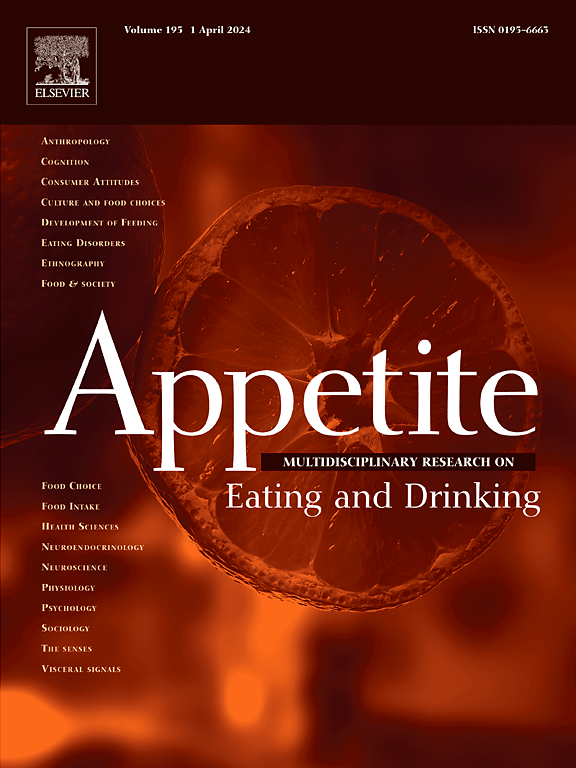Validation of the Teddy the Bear hunger and satiety rating scale in 3-5-year-old children
IF 4.6
2区 医学
Q1 BEHAVIORAL SCIENCES
引用次数: 0
Abstract
Using validated measures to assess children's hunger and satiety is important for eating behaviour research. Pictorial rating scales, such as the Teddy the Bear hunger and satiety rating scale (Bennett & Blissett, 2014), provide a child-friendly approach to assess hunger and satiety. The Teddy the Bear scale has been validated for use with primary school aged children (5–9 years); however, the scale has not been validated for use with preschoolers (3–5 years). Children's hunger ratings may also differ depending on individual characteristics, for example, their eating profile, but this remains to be examined. Hence, this validation study included preschool children aged 3-5-years-old (N = 115, 45 male, 70 female) who had been identified as having either typical (n = 76) or avid (n = 39) eating behaviour profiles. Children consumed a standardised meal and rated their pre- and post-meal hunger using the Teddy the Bear scale. Differences in pre- and post-meal ratings between children with typical and avid eating profiles, and differences in ratings of boys and girls were also examined. Findings showed that children reported lower hunger ratings after a standardised meal, compared to before a standardised meal. There was no difference in hunger ratings between children's eating profiles. However, exploratory analyses demonstrated that greater probability of having an avid eating profile was associated with greater change in ratings, and that greater energy intake was significantly associated with greater change in ratings. Overall, the Teddy the Bear scale may be a valid measure for assessing preschool children's hunger and satiety which is sufficiently sensitive to capture changes resulting from ingesting a meal. However, the scale may be less suitable for use with children aged 3 years.
使用有效的测量方法来评估儿童的饥饿感和饱腹感对于饮食行为研究非常重要。泰迪熊饥饿和饱腹感评定量表(Bennett & Blissett, 2014)等图形化评定量表为评估饥饿和饱腹感提供了一种儿童友好型方法。泰迪熊量表已在小学年龄儿童(5-9 岁)中得到验证,但尚未在学龄前儿童(3-5 岁)中得到验证。儿童的饥饿感评级也可能因个体特征(如饮食习惯)而异,但这一点仍有待研究。因此,这项验证研究的对象是 3-5 岁的学龄前儿童(人数为 115 人,其中男性 45 人,女性 70 人),他们已被确认为具有典型(人数为 76 人)或偏食(人数为 39 人)的饮食行为特征。孩子们吃了一餐标准化的饭菜,并使用泰迪熊量表评定他们餐前和餐后的饥饿感。研究还考察了具有典型进食行为特征的儿童与热衷进食行为特征的儿童在进餐前和进餐后的评分差异,以及男孩和女孩的评分差异。研究结果表明,与进餐前相比,儿童在进餐后的饥饿感较低。不同饮食习惯的儿童对饥饿感的评价没有差异。然而,探索性分析表明,更有可能具有热衷进食特征的儿童与更大的评分变化相关,而更多的能量摄入与更大的评分变化显著相关。总体而言,"泰迪熊 "量表可能是评估学龄前儿童饥饿感和饱腹感的有效量表,其灵敏度足以捕捉到进食后的变化。不过,该量表可能不太适合 3 岁儿童使用。
本文章由计算机程序翻译,如有差异,请以英文原文为准。
求助全文
约1分钟内获得全文
求助全文
来源期刊

Appetite
医学-行为科学
CiteScore
9.10
自引率
11.10%
发文量
566
审稿时长
13.4 weeks
期刊介绍:
Appetite is an international research journal specializing in cultural, social, psychological, sensory and physiological influences on the selection and intake of foods and drinks. It covers normal and disordered eating and drinking and welcomes studies of both human and non-human animal behaviour toward food. Appetite publishes research reports, reviews and commentaries. Thematic special issues appear regularly. From time to time the journal carries abstracts from professional meetings. Submissions to Appetite are expected to be based primarily on observations directly related to the selection and intake of foods and drinks; papers that are primarily focused on topics such as nutrition or obesity will not be considered unless they specifically make a novel scientific contribution to the understanding of appetite in line with the journal's aims and scope.
 求助内容:
求助内容: 应助结果提醒方式:
应助结果提醒方式:


